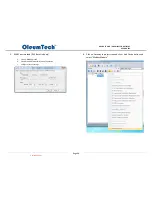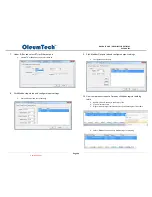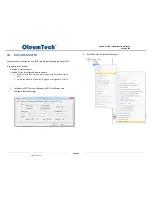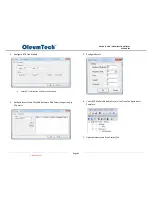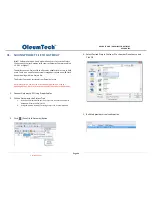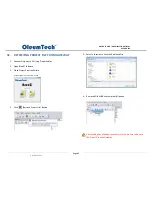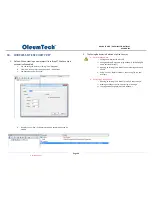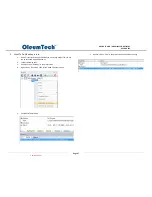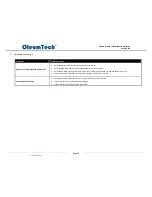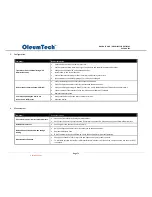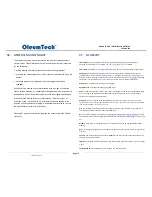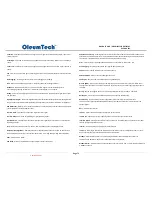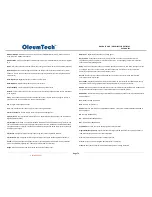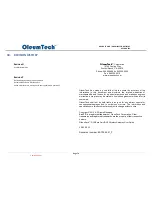
Page 73
DH1 BASE UNIT / DH2 WIRELESS GATEWAY
USER GUIDE
Count All
- a method for increasing an unsigned 16 bit integer each time a discrete input is opened or
closed (2 counts).
Count High
- a method for increasing an unsigned 16 bit integer each time a discrete input is closed (1
count).
Count Low
- a method for increasing an unsigned 16 bit integer each time a discrete input is opened (1
count).
CTS
- clear to send, a discrete signal indicating permission from the DCE for the DTE to send data to the
DCE.
Data Logging
– recording of data in two forms: event logging or trending.
DCE
- Data Communication Equipment
i.e.
computers and other intelligent devices.
Debounce
- the duration of time (ms) in which a discrete signal must remain stable prior to
acknowledging a change in state from “On/Closed” to “Off/Open” and vice versa.
Debug
- output to the Configuration Port from a connected device providing user insight into its status
and operation.
Digital (Discrete) Signal
- an electrical signal whereby minor fluctuations of the signal are not meaningful unless
they cross above or below a discrete threshold, at which point they are said to be “On/Closed” or “Off/Open.”
DIN Rail Mount
- Metal rail of a standard type widely used for mounting circuit breakers and industrial
control equipment inside equipment racks.
Discrete Input
- a method for measuring a digital (discrete) signal.
Discrete Output
- a method for producing a digital (discrete) signal.
Discrete Switch
- a device that produces a digital (discrete) signal represented in 0 or 1 for exception
reporting purposes.
DTE
– Data Terminal Equipment
i.e.
modems, terminals and any other unintelligent device.
Dual Float (Configuration)
- Liquid Level Sensor or High Level Switch Sensor set up with two floats to
read either product level and interface level liquid levels, or for high and high-high alert notification.
EFM
- Electronic Flow Meter.
End Node
- OleumTech network device that monitors process conditions.
Enhanced Site Security
- Enabling site security reduces the chance that transmitted information can be
accessed by unauthorized devices or cross-talk between other devices operating in the area. By default,
site security is enabled and it is recommended to keep this default setting.
Error
- Status of the last read operation performed by a Transmitter. A status of 0 = OK.
Event Logging
– recording of data when by triggered by a specific event
Exports
- Values sent to other devices in wireless network.
Extended Mode
- Used to set a slave ID higher than 255.
Full Duplex
- Four wire communication mode using handshaking.
Ground (GND)
- Ground or earth may be the reference point in an electrical circuit from which other
voltages are measured, or a common return path for electric current, or a direct physical connection to
the Earth.
Group
- ID used to configure one or more wireless gateways with its end nodes in a network.
Half Duplex
- Two wire communication mode which does not use handshaking.
Handshaking
- An automated process of negotiation that dynamically sets parameters of a
communications channel established between two entities before normal communication over the
channel begins.
Host
- Wireless ID of receiver.
Imports
- Values received from other devices in wireless network.
Initially On
- Upon Power cycle or updating device, the discrete output will be closed.
Interface (Level)
- Second level of fluid in tank such as water. Represented by the position of the lower
float on the digital liquid level sensor.
Interval
- Time delay in which the device will transmit data.
Jumper
- A short length of wire used temporarily to complete a circuit or to bypass a break in a circuit.
Represented by small pieces placed on pins of the circuit board.
Modbus
- A Master/Slave protocol used with programmable electronic devices that allows for
communication between many devices connected to the same network.
Modbus Master
- A device that polls (requests and sends) information from one or more Slave devices in
a Modbus network.
Controlled Copy

